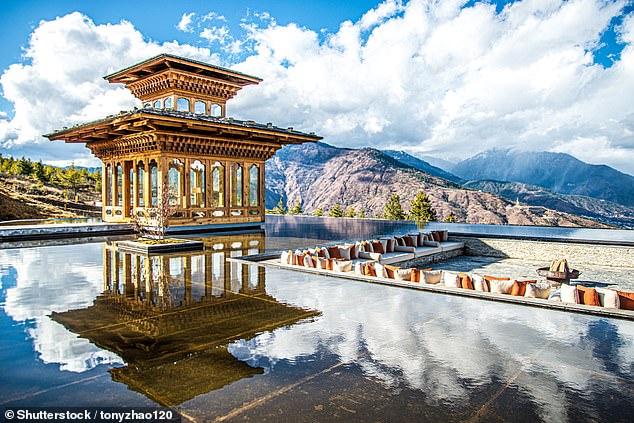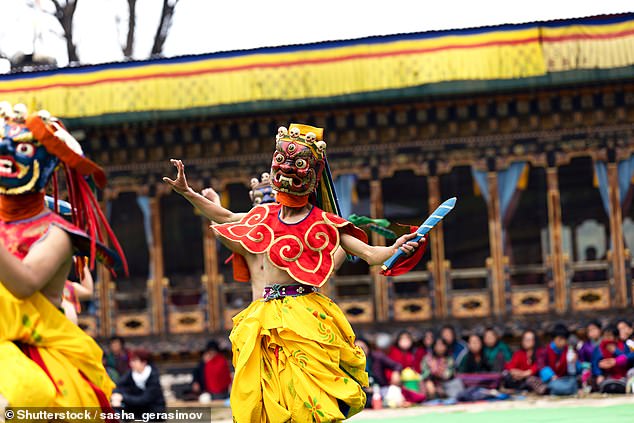Blessed be Bhutan: SARA WHEELER is mesmerised by the mountain kingdom, where the tranquillity is broken only by chanting monks (and the occasional yak herder)
At Damchen Lhakhang, a tiny 14th-century monastery in Bhutan’s Gangtey Valley, a dozen monks sit cross-legged, swaying gently as they chant. A hundred butter lamps flicker, and through glassless windows an alpine glow pours down over the foothills of the eastern Himalayas.
The monks, mostly young, have come from a remote valley for a week to practice their devotions; I had seen them spitting from the bus the day before. They sit in the chorten and turn over leaves with sacred texts written in a notebook like barbed wire on paper made from the boiled bark of the Himalayan firethorn.
Bhutan, wedged into the mountainous belt between China and India, is about the size of Switzerland and consists of a series of valleys. For most of the region’s history, the countries were cut off from each other, let alone the rest of the world.
Bhutan did not have an airport until 1983. Much of the less developed east still functions as a non-cash barter economy: you can pay taxes in hand-woven textiles.
‘Wellness retreats’ can be counterproductive – no matter how nice the massages and total isolation – as they tend to melt away as soon as the hard shoulder of the M1 comes into view. The Buddhist kingdom of Bhutan, however, is the real deal when it comes to rejuvenation breaks. To some extent, the entire country, known to the locals as Druk Yul, is a spa.
Beauty: Sara Wheeler travels through the Buddhist kingdom of Bhutan. Above, the sunset bathes the ‘magnificent’ Punakha Dzong fortress and the Mo Chhu River
After Damchen Lhakhang I hike to the 3,700-metre-high Kayche La pass, through forests of rhododendrons, hemlocks and poinsettias that are taller than me.
In the valley far below, black-necked cranes peck at the potato fields. Potatoes are the main cash crop, as Gangtey is too high even for red rice to grow. The sacred cranes, considered to be reincarnated beings, migrate to these wetlands for the winter.
King Jigme Khesar Namgyel Wangchuk, head of the government and the nation, rules as a benign Buddhist despot. It was his father, the fourth king, who devised the Gross National Happiness index to replace Gross National Product as an indicator of well-being.
People seem quite happy. There are 800,000 Bhutanese, but not a single traffic light in the entire country.

Sara stays at several Six Senses lodges during her visit. Above – the poolside chairs offer serene views of the mountains surrounding the Six Senses lodge in Thimphu, the capital
Most impressively, Bhutan is carbon neutral, meaning that its emissions are net zero. Most of the lowlands are covered in deciduous and coniferous forests.
Tibetan culture is reflected in all aspects of Bhutanese life, from the architecture (houses built of interlocking wooden panels, without nails, often with richly decorated eaves and trefoil arches) to the cuisine.
The unexpectedly fantastic Bhutanese food makes extensive use of Himalayan herbs, pungent honey, shrubs such as wild sea buckthorn, steamed dumplings (momo) and mountains of chillies. Paro in the west lies on the old trade route to Tibet.
A young man tells me that his grandfather walked those paths. ‘Gold traders came to my grandmother and stayed with her on their way to India. They offered her gold shards when they left the next morning, but she didn’t know what gold was, so she didn’t take them.’

Glory: Above is the Dordenma Buddha statue in Thimphu, which is 169ft high. On the slopes outside Thimphu, Sara has a one-on-one guided meditation with a Buddhist master
In every valley, at least one gung chim (farm) has a wooden tub where people can place and heat stones from the river, giving the whole village a chance to enjoy a famous Bhutanese hot stone massage. And this exceptionally relaxing therapy is available at Six Senses lodges in Thimphu and Bumthang.
I’m going to work the full Bhutanese way. In Gangtey I’ll have a steam box treatment – your head stays out of the box – and because I have banged up knees like everyone else my age, I’ll also try my first Sukshma vyayam, a yoga practice that’s supposed to loosen joints and free up energy. And, you know, it did!
To soothe my equally exhausted mind, I take part in a guided individual meditation with a Rinpoche, a Buddhist master, on the slopes outside Thimphu, the capital.

Every Bhutanese is required to make a pilgrimage to Taktsang, the nine-temple Tiger’s Nest Monastery in the Paro Valley (pictured above) at least once in their lifetime, reveals Sara
We sit there quietly as vultures circle in the thermals outside. My rinpoche tells me to meditate for one minute, 20 times a day. There is something holistic about everything in Bhutan.
In each valley I stay in a Six Senses lodge – luxurious wooden low-rise buildings that seem to rise out of the ground like the black pines. There are five of them in the country, strung together in a chain, and I travel between them in a car with a driver and a guide, who both stay with me for eight days. No journey takes longer than five hours.
Each of Bhutan’s twenty dzongs (regions) has its own fortress, most of which were built in the 17th century.
Punakha Dzong at the confluence of the Pho Chhu and Mo Chhu is the most magnificent. In the inner sanctum schoolgirls perform the kora, walking clockwise around walls of prayer wheels.
Every Bhutanese is required to make a pilgrimage at least once in their lifetime to Taktsang, the nine-temple Tiger’s Nest monastery in the Paro Valley. Taktsang is Bhutan’s top tourist attraction. (It’s worth taking trekking poles—my guide has a pair for me—for the three-mile hike up.)
People take religion seriously in Bhutan, and not just in the monasteries. They prostrate themselves in the streets on their way to work. Even the black-necked cranes circle Gangtey Monastery three times clockwise as they fly in from Tibet.
Around Gangtey and Punakha, semi-nomadic yak herders have come down just before summer and roam the lanes with their pack ponies. An elite group of Bhutanese herders harvest cordyceps sinensis, also known as the caterpillar fungus, which grows only above 11,500 feet and is highly prized in China for its immune-boosting properties.

Culture: Sara says she loves ‘everything about’ Bhutan. Above, a masked dancer performs
Bhutan has only one helicopter, but you can occasionally hear its wings buzzing in the valleys, landing to collect baskets of cordyceps from herders who have become wealthy. This rare fungus lives as a parasite on certain moths and is dangerous to collect.
Bhutan is no paradise. Thimphu already has a Starbucks. There is a brain drain (mainly to Western Australia). A klaxon of doom sounds from the new city of Gelephu, which His Majesty announced last year.
This ‘special administrative region’ will have a rail link to India – the first ever to connect Bhutan to the wider world. And despotism always has a dark side. The gross national happiness of the persecuted ethnic Nepali community is not factored into the overall equation.
Yet the Bhutanese cling to their cultural identity. Since opening up to the outside world in the 1970s, the country has promoted high-income, low-impact tourism, charging $100 per person per day as a sustainable development fee—essentially a tourist tax. It seems to be working.
In many ways Druk Yul, Land of the Thunder Dragon, is a model of what tourism can be. I love everything about it.
